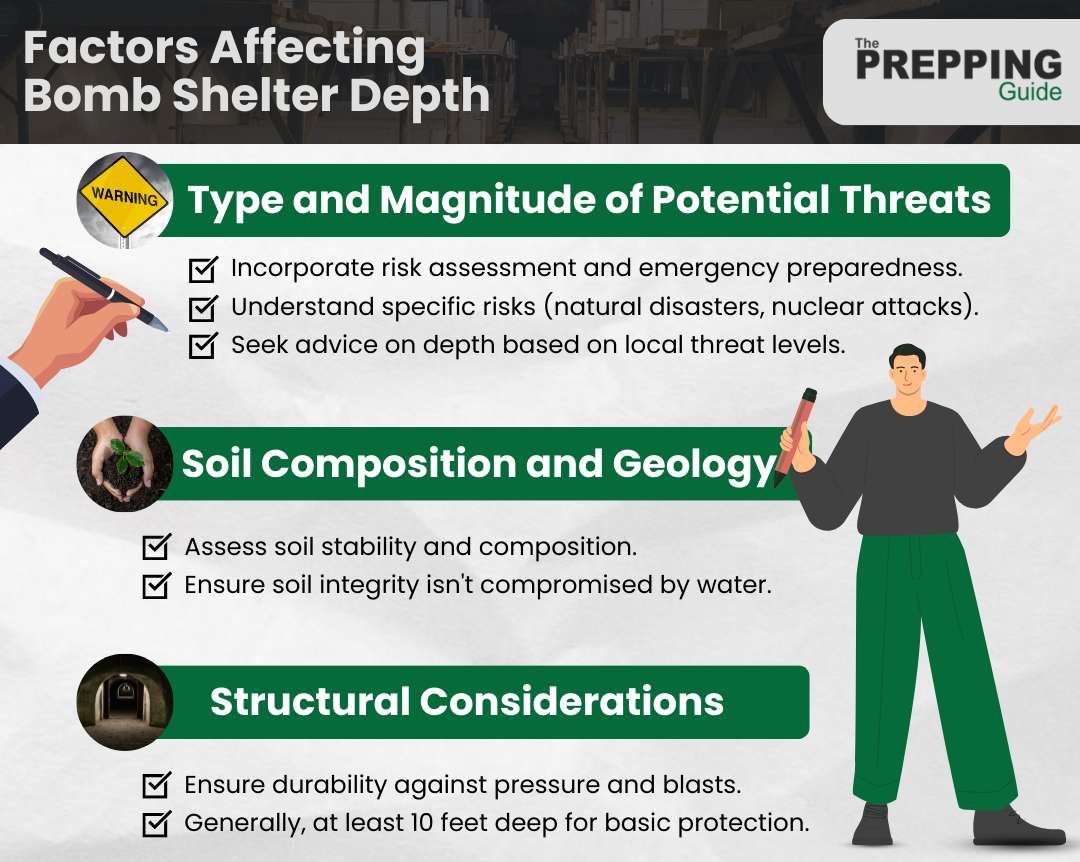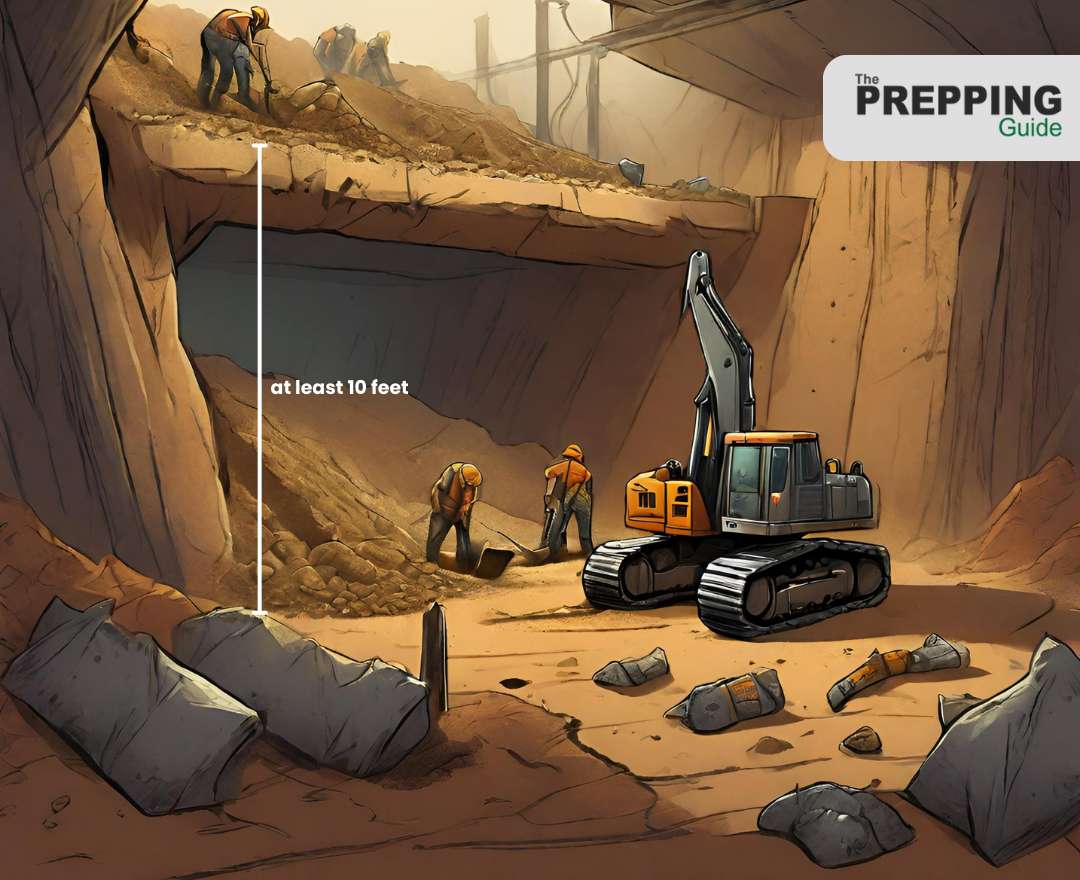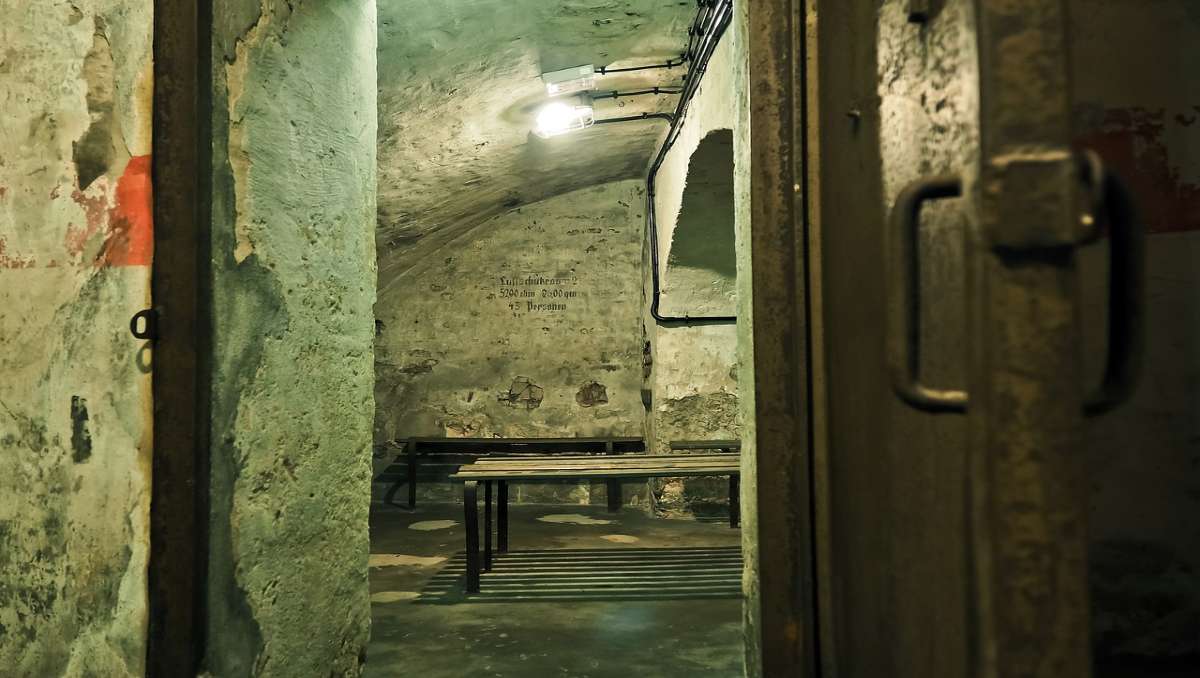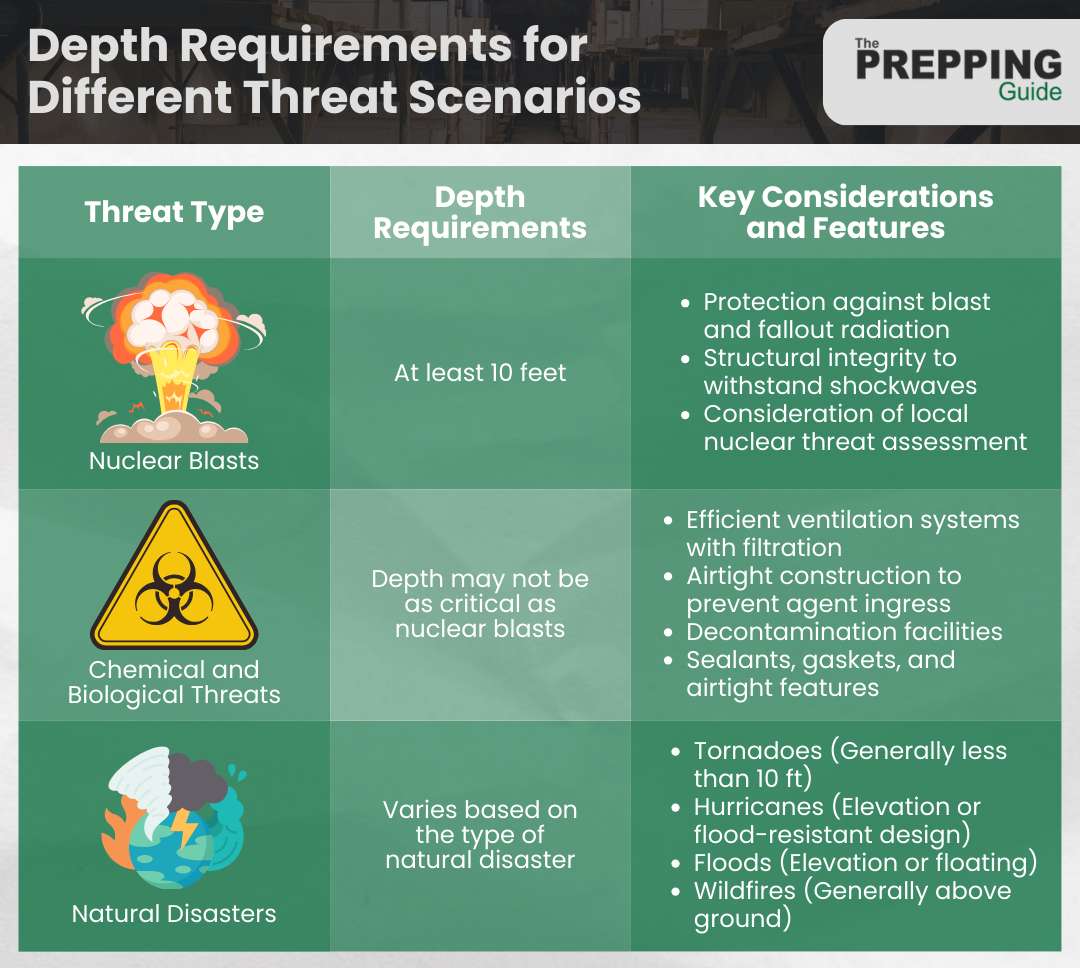Building a bomb shelter is like constructing a fortress, providing you with a sanctuary amidst chaos. Just as a skilled general assesses the battlefield before strategizing their defense, you too must carefully consider various factors when determining how deep your bomb shelter should be.
A bomb shelter should typically be built at least 10 feet underground to provide adequate protection against the impact of nuclear blasts and fallout radiation. This depth helps minimize the risk of structural damage and exposure to harmful radiation.
This article will delve into the factors influencing bomb shelter depth and guide you through the calculation process. We will explore guidelines and recommendations, structural design considerations, and even discuss threat scenarios that may require varying depths.
Factors Influencing Bomb Shelter Depth
When determining the depth of a bomb shelter, you need to consider three key factors.
The first is the type and magnitude of potential threats that could be faced in your area. Secondly, soil composition and geology play a crucial role in determining how deep your shelter should be to provide adequate protection. Finally, structural considerations are important for ensuring the safety and stability of the shelter.

Type and Magnitude of Potential Threats
To accurately determine the depth of your bomb shelter, consider the type and magnitude of potential threats you may face. Security measures, risk assessment, emergency preparedness, hazard analysis, and threat assessment are all crucial factors to take into account.
The deeper your bomb shelter is, the better protected you will be against various threats. For example, if you live in an area prone to natural disasters like tornadoes or earthquakes, a deeper shelter would provide more security against collapsing structures.
Additionally, if you’re concerned about potential nuclear war, a deeper shelter can offer better protection from the blast and radiation effects.
It’s essential to consult with experts in bomb shelter design and construction who can conduct a thorough analysis of your specific location and advise on the appropriate depth based on these factors.
Soil Composition and Geology
The strength of the ground beneath your feet can greatly impact the level of protection your underground bunker offers. Soil stability and geology are crucial factors to consider when determining the depth of your bomb shelter.
Before construction, it’s essential to conduct geological surveys to assess the composition and stability of the soil. This information will help you determine if excavation techniques need to be modified or if additional support structures should be implemented.
Moreover, understanding groundwater levels is vital, as excessive water can weaken the soil and compromise the integrity of underground structures.
By considering these factors, you can ensure that your bomb shelter is built at an appropriate depth, offering maximum protection against potential threats.
Structural Considerations
Constructing a bomb shelter involves carefully considering the structural aspects to ensure it provides a secure haven underground. When it comes to the construction of a bomb shelter, reinforcement techniques play a crucial role in ensuring its strength and durability.
The depth requirements for a bomb shelter depend on various factors, such as the type and size of bombs anticipated, as well as the desired level of protection. However, typically, bomb shelters should be at least 10 feet deep to provide adequate shielding from explosions and debris.
It is important to note that building deeper shelters may pose technical and engineering challenges due to increased soil pressure and excavation difficulties.
Additionally, air purification systems are essential in creating a safe environment within the shelter by filtering out harmful gases and contaminants.
How Deep Should Bomb Shelter Be? The Calculation
Determining the ideal depth for a bomb shelter involves careful calculation, considering various factors such as:
- calculation methods
- depth requirements
- excavation challenges
- reinforcement techniques, and
- ventilation systems
The calculation method used to determine the depth requirements of a bomb shelter primarily depends on the type of threat it’s designed to protect against. For instance, if the shelter is intended to withstand nuclear explosions, experts recommend using the ‘Nuclear Bomb Effects Computer,’ which takes into account variables like blast overpressure and radiation intensity.
Excavation challenges must also be considered when determining optimal depth. Factors such as soil composition, water table levels, and geological conditions can affect excavation efforts and may require additional engineering measures.
Reinforcement techniques play a crucial role in ensuring structural integrity. Reinforced concrete walls and ceilings provide strength, while steel reinforcements offer added support against external forces.
As a general rule, the shelter should be at least 1 foot underground for every kiloton of explosive yield. For example, if anticipating a 10-kiloton blast, the shelter should be constructed at a depth of at least 10 feet.

This calculation aims to provide sufficient earth cover to shield occupants from the destructive force and radiation effects of a detonation, enhancing the shelter’s effectiveness in safeguarding against potential threats.
Guidelines and Expert Recommendations
Government guidelines and recommendations for bomb shelters serve as crucial directives to enhance public safety and resilience in the event of potential threats.
1. Depth and Construction Standards
Bomb shelters are designed to withstand the impact of various explosive threats, and expert recommendations often emphasize a minimum depth of at least 10 feet below ground level. This depth provides crucial protection against the destructive forces of nuclear bomb and reduces exposure to radiation.
2. Adherence to Local Threat Assessments
Expert recommendations for bomb shelters emphasize the importance of tailoring construction and preparedness measures to local threat assessments. The type and yield of potential explosives, as well as the proximity to potential targets, are factors that influence shelter guidelines.
3. Regular Updates and Technological Advancements
The field of bomb shelter construction continually evolves with technological advancements and changing threat landscapes. Governments and experts regularly update guidelines to incorporate the latest research and innovations. This includes improvements in materials, construction techniques, and shelter functionalities. Staying informed about these updates ensures that bomb shelters remain at the forefront of safety and resilience.
4. Public Awareness and Education
Guidelines for bomb shelters extend beyond construction specifications to encompass public awareness and education. Experts emphasize the importance of educating communities about shelter locations, emergency procedures, and the significance of preparedness.
Structural Design Considerations
When constructing a bomb shelter that needs to be deeper, there are several reinforcement techniques you should consider. These techniques ensure the structural integrity of the shelter and provide added protection against potential threats.

Reinforcement Techniques for Deeper Shelters
Reinforcing bomb shelters for greater depth involves employing various techniques to enhance structural integrity and ensure the safety of occupants. Some key reinforcement techniques for deeper bomb shelters include:
Increased Wall Thickness and Density:
As shelter depth increases, reinforcing walls with thicker and denser materials becomes crucial to withstand the increased pressure and potential structural stresses. Using materials with high density and strength, such as reinforced concrete or specialized blast-resistant composites, helps improve the shelter’s overall robustness.
Blast-Resistant Doors and Entrances:
The entrances and doors of bomb shelters are critical points vulnerable to the impact of explosions. Reinforcing these areas with blast-resistant doors, hinges, and frames helps prevent structural failure and ensures a secure seal during an emergency. The doors should be designed to withstand high-pressure waves and minimize the risk of debris entering the shelter.
Specialized Roof and Ceiling Design:
Deeper bomb shelters require careful consideration of roof and ceiling design to withstand increased loads and potential collapse. Implementing domed or arched structures can distribute pressure more effectively than flat designs. Reinforcing the roof with additional layers of blast-resistant materials or installing a suspended ceiling system provides added protection against debris and structural damage.
Shock-Absorbing Systems:
Integrating shock-absorbing systems into the structure can help dissipate the energy generated during a blast. This includes incorporating seismic dampers, shock isolators, or other engineering solutions that absorb and disperse the impact forces. These systems contribute to the overall stability of the shelter and reduce the risk of structural failure.
Ventilation and Access Points
When designing your bomb shelter, it’s crucial to consider ventilation systems that ensure proper air circulation. Without adequate ventilation, the air can become stagnant and hazardous.
Incorporating access points into your shelter’s design is also essential for emergency situations. These access points should be strategically placed to allow for quick entry and exit when needed. Additionally, filtration systems play a vital role in maintaining clean air by removing contaminants and toxins from the environment.
Lastly, don’t forget about emergency exits. They should be well-marked and easily accessible to ensure a safe escape during critical moments. By considering these factors, you can create a bomb shelter that not only provides security but also promotes comfort and accessibility for you and your loved ones.
In this video, Raf Sanchez of NBC News reports from Ashkelon, Israel, and navigates into one of the shelters used by inhabitants to take protection from bomb attacks.
Depth Requirements for Different Threat Scenarios
In considering the depth requirements for different threat scenarios, it’s important to take into account the potential impact of nuclear blasts. The deeper a bomb shelter is, the better protected you’ll be from the effects of radiation and heat generated by such explosions.
Nuclear Blasts
When it comes to nuclear blasts, the depth requirements for bomb shelters are particularly important due to the potential hazards of nuclear fallout and radiation exposure.
To ensure effective protection against radioactive particles, experts recommend that bomb shelters be buried at least 10 feet underground. This depth provides an adequate barrier against radiation and minimizes the risk of contamination.
Additionally, when constructing a bomb shelter for nuclear threats, it is essential to stock up on survival supplies such as food, water, medical kits, radiation masks, and communication devices. Adequate emergency preparedness can significantly increase your chances of survival in the event of a nuclear disaster.
Chemical and Biological Threats
The depth requirement for shelters designed to protect against chemical and biological threats varies depending on the specific agents involved and the level of protection required. Generally, bomb shelters intended for chemical and biological threats need to be designed to prevent the ingress of harmful substances, including gases and aerosols.
For protection against airborne chemical and biological agents, shelters should incorporate highly efficient filtration systems. The depth of the shelter should be sufficient to accommodate these systems, which may include high-efficiency particulate air (HEPA) filters for biological threats and activated carbon or other specialized filters for chemical agents.
The depth of the shelter should also allow for the integration of ventilation systems designed to maintain a positive pressure inside the shelter. This positive pressure prevents external contaminants from entering and ensures that any potential leaks occur outward, minimizing the risk to occupants.
It’s important to note that specific guidelines for shelter depth can vary based on the nature of the chemical and biological threats relevant to a particular region.
Natural Disasters
The depth requirement for shelters designed to protect against natural disasters varies depending on the specific type of natural disaster and the intended purpose of the shelter.
For tornadoes, storm shelters are commonly recommended. These shelters are often designed to withstand the impact of debris and high winds associated with tornadoes. The depth of a tornado shelter is typically less than that of bomb shelters designed for other threats. The shelter’s primary goal is to provide protection from flying debris and the structural damage caused by tornadoes.
Shelters in coastal areas prone to hurricanes and storm surges may not necessarily be underground but should be designed to withstand the strong winds and potential flooding associated with these events. The emphasis is on structural integrity, elevation above potential flood levels, and protection against wind-borne debris.
Earthquake-resistant structures focus on overall construction and engineering rather than depth below ground. In earthquake-prone regions, buildings are designed to sway and absorb seismic energy. Underground shelters may still be relevant for earthquake preparedness, providing protection from falling objects and collapsing structures.
It’s crucial to note that the specific depth requirement for natural disaster shelters depends on regional considerations, building codes, and the prevalent types of natural disasters in a given area.
Here’s a simplified table comparing the depth requirements of threats from nuclear blasts, chemical and biological threats, and natural disasters:

Technical Challenges and Solutions in Deep Bomb Shelter Construction
When constructing a deep bomb shelter, you’ll encounter various engineering challenges. Excavating to great depths requires specialized techniques to ensure stability and prevent collapse. Additionally, modern construction methods and materials play a crucial role in creating a safe and secure underground structure.
Engineering Challenges Associated with Deep Excavation
When it comes to engineering challenges in deep excavation for bomb shelters, there are several factors to consider.
Firstly, excavation techniques play a crucial role in ensuring safety and stability throughout the process. Engineers must utilize proper equipment and methods to prevent the collapse or instability of surrounding soil.
Additionally, implementing effective safety measures is essential to safeguard workers and maintain structural integrity.
Soil stability is another significant concern that needs careful evaluation and monitoring during excavation. It involves assessing soil properties, such as cohesion and angle of internal friction, to determine appropriate support systems or reinforcement methods.
Lastly, groundwater control is vital to prevent water seepage into the excavated area, which could compromise stability or lead to flooding.
Modern Construction Techniques and Materials for Deep Shelters
With advancements in technology, engineers have developed innovative methods for constructing deep shelters and bunkers that overcome the challenges of excavation. One such technique is the use of reinforced concrete walls, which provide the strength and durability necessary for underground structures.
Additionally, lightweight materials like fiberglass and carbon fiber composites are used to reinforce the structure without adding excessive weight.
Combining modern construction techniques with appropriate materials ensures that deep shelters can withstand various external pressures while providing a safe haven during times of crisis.
Ventilation and Air Purification Systems for Deep Shelters
For optimal safety and comfort in your underground refuge, it’s essential to invest in state-of-the-art ventilation and air purification systems.
These systems play a crucial role in maintaining adequate airflow, removing contaminants, and ensuring high-quality air for an extended period.
Advanced ventilation systems utilize air filtration techniques that effectively eliminate harmful pollutants such as dust, smoke, and chemical agents.
Additionally, incorporating efficient air quality monitoring mechanisms allows you to assess the atmosphere inside the shelter constantly.
Regular maintenance is necessary to ensure these systems operate at peak performance levels.
To promote energy efficiency, consider installing energy recovery ventilators that minimize heat loss while exchanging stale indoor air with fresh outdoor air.
You might be interested in exploring the cost of building a bomb shelter.
Resilient Depths: Crafting Effective Bomb Shelters
In conclusion, determining the depth of a bomb shelter requires careful consideration of various factors. The guidelines and recommendations provided by experts serve as valuable references in this process.
Structural design considerations should also be taken into account to ensure an effective and efficient shelter. Moreover, understanding the different threat scenarios and their corresponding depth requirements is crucial.
Finally, technical challenges may arise during construction, but with innovative solutions, building deep bomb shelters is feasible. Remember, when it comes to protecting lives, going deeper is better than taking chances on the surface.
